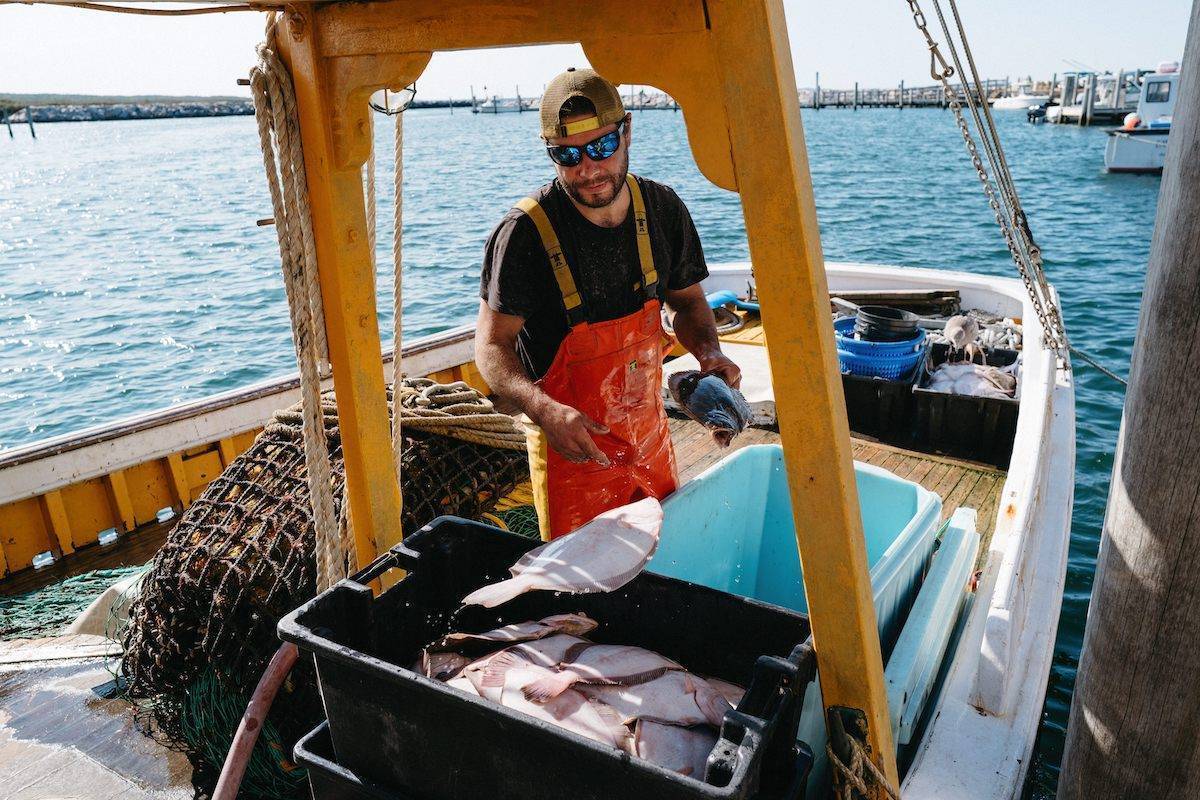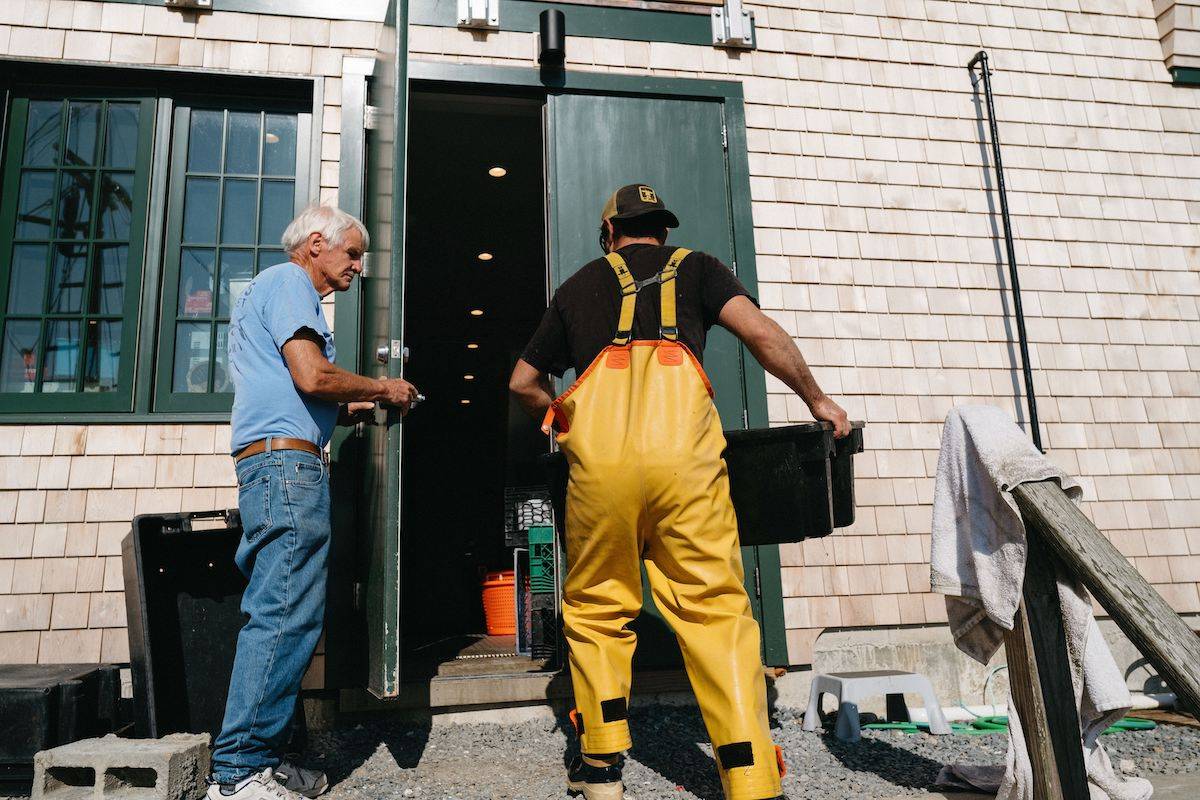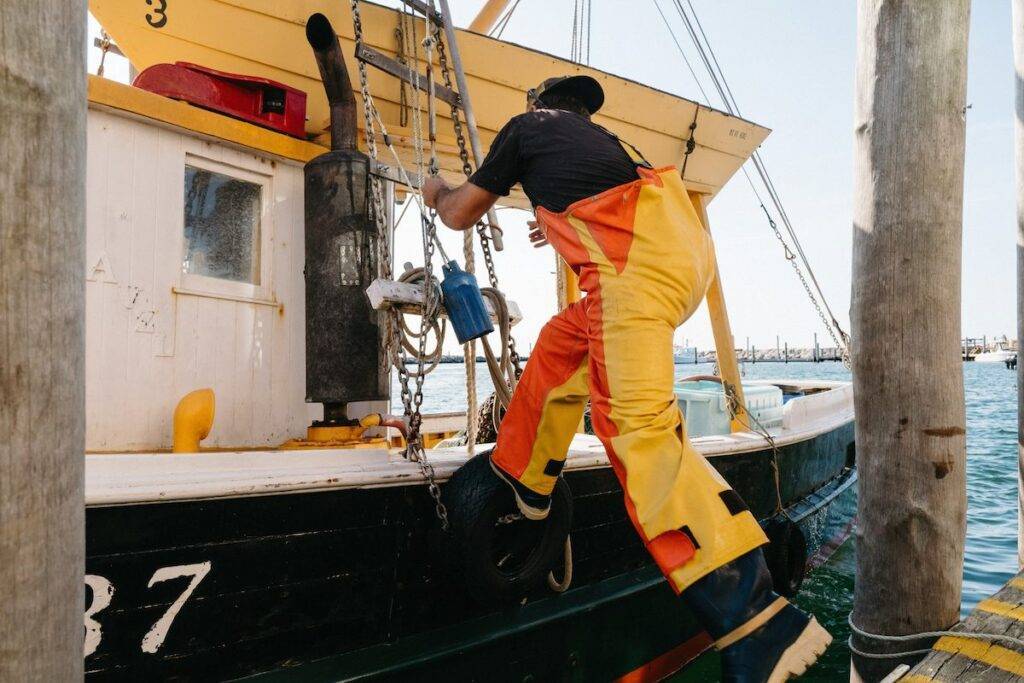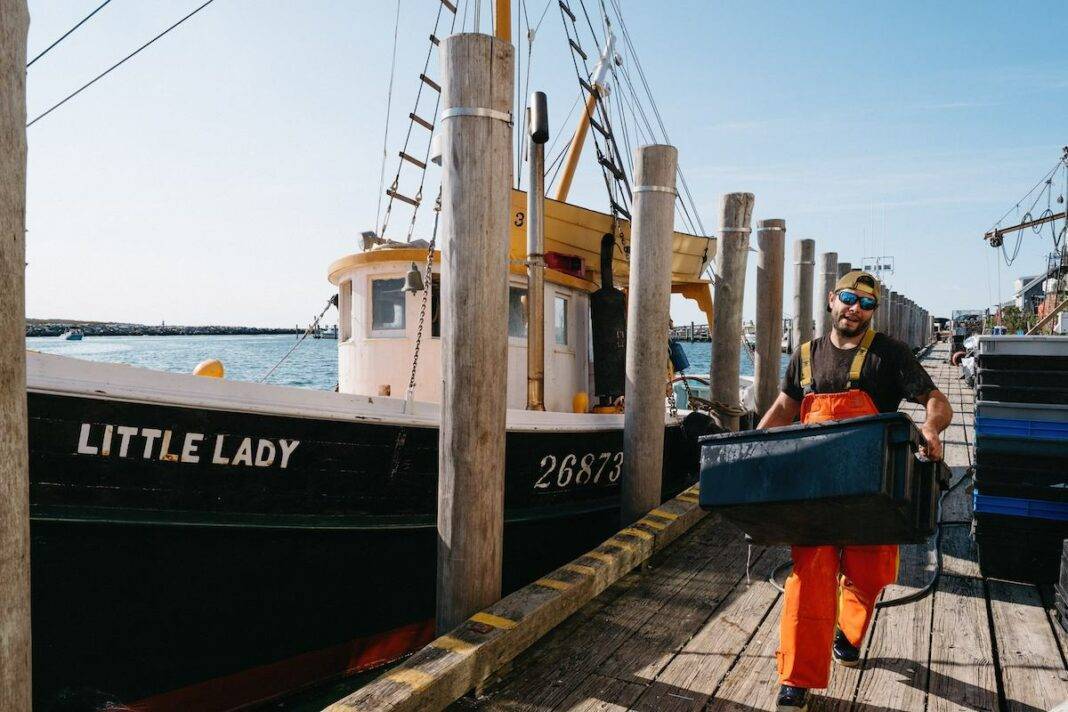Though some species are in decline, Vineyard fishermen are keen to put these catches on our plates.
“My grandfather built this boat in the mid to late ’30s,” says Denny Jason, Jr., a second-generation fisherman, standing next to The Little Lady, which motors from Menemsha in mornings in search of fluke. “He started fishing in Menemsha Bight and fell in love with this Island and the rest is history. The boat builders did not expect her to last more than 30 years and here she is at 94. I’ve spent a lot of my life just taking care of this boat.” The Little Lady has manual steering and a net that drops over the side that catches the fluke and other fish. “It’s one of the last single, side-rig galleys, as far as I know.”
“You’re kind of born into it,” Jason, 36 years old, says about fishing and following in his father and grandfather’s steps. He now spends eight to ten hours on a trip, four to five days a week, and is one of the Island’s main suppliers of fluke, a type of flounder locals refer to as Vineyard sole. Fluke can be found in Vineyard Sound and off Aquinnah.
“You can’t beat it,” he says. “It’s one of the cleanest fishes you can eat. I’ll put it right up there with anything.”
Jason’s antique boat is one of 75 to 100 working fishing boats currently based on Martha’s Vineyard. Fluke is one of 11 fish species, along with nine types of shellfish that local fishermen catch from the waters surrounding Martha’s Vineyard. Like Jason, a number of them still drop fish off daily to fish markets and at the Menemsha docks.
If you want to buy local, any of these fish is a good idea, says Shelley Edmundson, a marine biologist and executive director of the Martha’s Vineyard Fishermen’s Preservation Trust, which works to support the local fishermen who bring in this wild catch and to educate chefs and consumers about what’s around us. “Focusing on what we have in our waters that is plentiful and overabundant is great.”
This Vineyard catch ends up at fish markets for sale or with wholesalers. Some of it moves off-Island. The Fishermen’s Trust purchased the former Menemsha Fish House next to Larsen’s Market not long ago as a way to sell just Vineyard fish and shellfish wholesale to local restaurants, food trucks, and caterers. Deliveries are listed on a blackboard each day, which recently included 32 local eateries. With each delivery, restaurants get an information card listing the local boat or boats that brought in the catch. The day I toured the Menemsha facility, Beau Begin, who operates a mobile raw bar he calls the “Clambulance,” stopped by to pick up a bag of Vineyard oysters for an upcoming event. With a state grant, the Fishermen’s Trust recently completed a 22-page “Seasonal Seafood of Martha’s Vineyard” guide for chefs, especially those new to the Island, including characteristics, recommended preparations, and nutritional information for each species.
Locally caught fish includes some familiar species like lobster, striped bass, bluefish, fluke, oysters, scallops, and clams. Some fish on the list are not as recognizable, or might be overlooked when we are used to buying our favorites. Tautog is one species I had never tried. Yet the first week of September, there it was at Larsen’s Market: pristine, pinkish-white filets filling the tub. Owner Betsy Larsen and her sister Kristine at the Market both say they love tautog, which is available seasonally in the fall.
Some species are relative newcomers — a result of warming seas — and others are on the decline. Black sea bass, a mild delicious white fish like fluke, is now one of our most common Vineyard fish, growing steadily in popularity. Ten years ago they were not as common. As waters have warmed, they have gradually moved in and found a home here. Fishermen are also catching more mahi mahi, and consumers will occasionally see it in local fish markets.
Scup have been a constant in waters here. The Narragansett tribe called them mishscuppaug, from which the names scup and porgy are derived. Yet frustratingly to some, it’s rarely sold or cooked in restaurants. A relatively small silvery fish with sweet, tender, and mild white flesh, scup used to be a local staple. For decades, especially in the ’20s and ’30s, fishermen caught scup by “trap fishing,” a system of wooden stakes driven into the ocean floor along the North Shore that held nets and trapped so many fish they were heavily exported as well. But scup fell out of favor, mostly because of the small size of the fish and proportional bones. Since it is still abundant here, many would like to see this sustainable species make a comeback with consumers. Meanwhile, you can fish for it on your own recreationally or head out on the Skipper, a charter out of Oak Bluffs that takes 20 to 30 people. Fishermen sometimes catch and sell scup as bait.


We also don’t typically find whelk, also known as conch, in local markets, even though it is the largest fishery on the island and one of the top 10 fish brought in. In 2020, some 290,000 pounds of conch were landed here. Next in landings were local oysters at 175,000 pounds that same year; 121,000 pounds of black sea bass; followed by 97,000 pounds of lobster. (These state totals don’t include fish under federal permits or sea scallops.) Most of the conch catch goes off-Island to New Bedford and New York processing warehouses for distribution mostly to Asia, where it is popular. One Island chef, Jamaican-born Deon Thomas, serves conch at his restaurant, Deon’s, and he wrote Deon’s Island Conch Cookery hoping to introduce Vineyard consumers to conch delicacies.
The once thriving lobster fishery on the Island is now mostly concentrated in the colder waters off Maine and Canada. Local fishermen here still bring lobsters in, but far fewer than in past decades, and their fishing areas are farther offshore.
“The fishery has changed and you have to adapt,” says Tubby Medeiros, a seventh-generation Island fisherman whose ancestors emigrated from the Azores. Medeiros tends not only to his lobster traps, but to about 120 traps for scup, sea bass, and conch. He especially enjoys taking his son (now also a Tisbury police officer) on the boat as a sternman. “He’s awesome on the deck of a boat. It’s a heartfelt day when I go out with him.”
Medeiros says he feels blessed to have been able to fish for the past 30 years. He builds all his own lobster traps and gear. “After 12 to 14 hours on the water, you’re beat. It’s a hard way to make a living, but it’s a good feeling to be able to supply the Island with quality fish and lobster.”
The other Vineyard shellfish — oysters, bay scallops, and clams — seem to be thriving, a true success story for the island. Oyster farming here, now a boon for fishermen and consumers, largely started in 1998. That was the year the Martha’s Vineyard Shellfish Group, under biologist Rick Karney, got a federal grant to provide technical assistance to local fishermen to initiate approximately 12 aquaculture farms in Katama Bay. The Vineyard now has 19 aquaculture ventures, including in Oak Bluffs, Tisbury, and Chilmark.
Maintenance of the bay scallop fishery here, a local favorite and delicacy available in late fall/winter, is supported by the MV Shellfish Group run by marine biologist Emma Green-Beach and crew. Working from local hatcheries, the organization augments the wild catch by adding oyster, clam, and bay scallop seed to Island waters in all six towns. In 2019, they grew and released 13.5 million baby quahogs, 27.5 million baby scallops, and 12.5 million oyster seeds. That same year they also released more than 146 million scallop eggs to supplement the wild populations. Without this program, started nearly 50 years ago, the Vineyard might be like many other coastal areas on the East Coast without bay scallops due to environmental degradation. The landings of bay scallops have decreased over the past few years and that decline in the supply has meant prices climbed.
The Shellfish Group also monitors the entire ecosystem, working on eelgrass and oyster habitat restoration, and recycling shells from restaurants in the process.
If there’s a local resource people should consume, says Edmundson, it’s clams. Available year-round, they rarely sell out at local markets, especially the medium sized cherrystones and quahogs or chowder clams, not as popular as the smallest littleneck clams. “We have a lot of clams on this Island that’s thanks to Emma’s group and the hardworking fishermen who harvest them,” says Edmundson. More than 71,000 pounds of clams were harvested in 2021.
Getting clear on what’s sustainable
Fishing in Massachusetts, including the Vineyard, is regulated and managed by a number of state and federal agencies, including the MA Division of Marine Fisheries and the National Oceanic and Atmospheric Administration (NOAA). But Edmundson says consumers sometimes get conflicting information about which fish to consume and which to avoid.
Consider the striped bass fishery here as an example. The highly respected Monterey Bay Aquarium’s Seafood Watch Program puts striped bass in its “avoid” column because of concerns about overfishing. Commercial striped bass fishermen in this state, however, have been following strict guidelines for years, which have helped successfully rebuild stocks. Current restrictions remain, including a daily limit of 15 fish, at least 34 inches long, and fishing only two days a week. When the quota for striped bass is met, the striped bass season ends.
“Sustainable seafood is a very hard thing to define [as] there are so many different viewpoints,” Edmundson explains. “What our fishermen are landing locally are carefully regulated by state and federal agencies. We’re not defining it; we’re supporting their rules. You can’t take one source to define what something is sustainable or not. You’re looking at a smaller community of fishermen. They’re doing things at a different scale. By the nature of our smaller harbors we can’t support large-scaled industrialized fishing business, so that makes choosing locally caught fish already more sustainable.” Edmundson adds she does not want to tell people how to live their lives or what fish to eat or not eat but “it’s really important to understand fishing seasons,” she says. “If more people had that as a tool in their toolkit, it would help us all make more sustainable choices when we got to the fish market.”
Fewer fishermen, fewer rights
The fleet on Martha’s Vineyard is considerably smaller than in past decades, thanks to some major consolidation affecting us locally. Those close to the industry say that if we want to keep the Island’s fishing heritage alive, they need to actively work at it.
“We’re at a place where we’ve lost a lot of our fishing rights to fish our waters,” says Wes Brighton, who fishes for sea scallops, lobster, Jonah crab, and squid. Decades past, fishermen could apply for permits for free, but those permits got privatized over time. Some fishermen took this opportunity to sell their permits and retire. But somewhat like consolidation in other food industries, larger corporations — even venture capitalists — started investing, buying up permits, and monopolizing the industry, fish by fish. Permit prices, depending on the fishery, can now reach from hundreds of thousands of dollars into the millions. In the process, Brighton says, smaller fishing communities like that on Martha’s Vineyard, began to lose access and to face daunting, if not prohibitive start-up costs as well as lost waterfront and infrastructure.
We are surrounded by water and we have the opportunity and privilege to feed ourselves with our own natural resources and to do so sustainably. It strengthens the community and the families that live inside that community.
Wes Brighton, Vineyard fisherman
“There were way more fishermen,” says Brighton, referring to the era before these changes occurred, along with burgeoning regulations, and industry management. “There were probably 12 draggers out of Menemsha and a lot of other draggers around the Island. There was just a lot more fishing.”
In an effort to intervene, Brighton and others formed the non-profit Fishermen’s Trust in 2011 to look for ways to help independent fishermen and the next generation compete. The group got active in 2014. One way is to purchase permits when they become available through Trust fundraising. “We purchase them at market rate, similar to Affordable Housing Trust, then we work to finance the asset back to the fisherman,” Brighton explains. They’ve also been able to purchase sea scallop quotas through donations and investor help. Those will be kept in perpetuity and are being leased to Vineyard fishermen at affordable rates, Brighton says.
“There’s no shortage of challenges,” he laments. “It’s not easy to compete against well-funded large corporations. It’s crucial to maintain those assets for our community. We are surrounded by water and we have the opportunity and privilege to feed ourselves with our own natural resources and to do so sustainably. It strengthens the community and the families that live inside that community.”
The Fishermen’s Trust stepped up big time to help local fishermen who had fewer places to sell their catch when restaurants closed during the pandemic. Trust President John Keene recounts that they got a grant to purchase about 40,000 pounds of black sea bass and 2,500 pounds of scup from Island fishermen. That was turned into 144,00 meals of fish chowder and stew then distributed to Island food pantries, the Greater Boston Food Bank, and seniors’ facilities. “By getting this grant, we were able to buy a lot of sea bass, give the fishermen a good price, and extend their season into the fall,” says Keene, a Chilmark resident and owner of John Keene Excavation. “That was huge.”
The Trust bought the former Menemsha Fish House in January of 2021 and created The MV Seafood Collaborative, a wholesale facility, to move what our local fleet catches in waters around the Island or harvests here. With a grant from the MV Savings Bank, the Trust supplied that facility with an ice machine capable of producing five tons of ice a day. Boats can now unload fish and stock up with ice for the trip the next day, and all catches can be immediately iced down when they get to the dock. Previously, large amounts of ice like this, which help improve the quality of caught fish, were not available in Menemsha.
“To have a place that you know if you go out and come back in to, and you know you’re going to be able to sell your catch … Without being able to sell your fish, you can catch all the fish in the world — we could supply and help people with all these permits — but if there’s no markets to buy the seafood, it’s all irrelevant,” explains Keene.
Because they are non-profit, Keene said they walk a fine line between helping the fishing community and not harming other for-profit businesses, such as fish markets, which also buy wholesale for distribution to restaurants. “It’s really tricky for us,” Keene says.
Looking toward the future, both Keene and Edmundson say they are encouraged by younger residents — still mostly men — who can uphold the Island’s fishing tradition. “I feel really optimistic,” Edmundson says. “We have a strong group of younger fishermen coming up who are interested and on the edge of taking the baton over. It gives me a lot of hope for the future to see this kind of progression happening. With older fishermen ready to retire, we have to be proactive with loan structures and programs now to help bridge the financial gap when it is time.” She adds, “A lot of younger fishermen … they see the big picture and they want to be part of the solution. They want to make sure they’re doing things right.” Nick Wilbur is one of these young fishermen trying to make it all work. He fishes for lobster, conch, sea bass, triggerfish, and bonito from his vessel, Little Feat, out of Menemsha. “As far as the future goes, one of my biggest worries is ocean acidification. That freaks me out in terms of the future for my daughter and son. What’s the ocean going to be like? I try to be as good of a steward as I can.”

Fishing’s future
Any consideration of fishing has to include climate change and how we are going to adapt to it. Those focused on the future of fishing on the Island, including Edmundson, who participated in the recently released Climate Action Plan (dubbed The Vineyard Way), are keeping that sector of the economy front and center.
“How do we help local foragers, farmers, and fishers thrive?” the report starts out, outlining its aims. “Martha’s Vineyard is historically a foraging, fishing, and farming community. In a time of climate change, when we need to rely on food grown as close to home as possible, how can we ensure this is part of our future? How can we be better prepared for extreme events?”
One of The Vineyard Way’s goals is to increase aquaculture production by 30 percent by 2030. To do this, the report recommends developing a business plan to analyze the potential of building an on-Island shellfish processing facility, as well as undertaking an Island-wide analysis to identify new areas for additional shellfish/seaweed production.
To achieve increasing local purchasing of locally harvested seafood by 2030, the recommended actions include establishing a labeling and marketing campaign for local seafood, and working to increase institutional purchasing of local seafood in the schools and at the MV Hospital.
A final goal of the plan is to ensure that by 2032, commercial fishing and aquaculture are safeguarded as sustainable livelihood options. The report proposes working with towns to ensure that waterfront space is prioritized and preserved to support commercial fishing; developing fish clubs or mentorships to increase interest for the next generation of fishers; expanding collaboration between fishermen and scientists to understand projected changes to future fisheries; maintaining and increasing permits for current species through buyouts and loan program partnership; and developing communication between fishermen and regulators to help both parties identify and adapt to changing climate conditions.
“Sustainably fished, the ocean can provide food for years to come,” says Keene. “Historically, the fish industry has been a huge industry here providing food and commerce and income for families. It’s really important to keep it alive because once it stops, it just won’t come back.”


